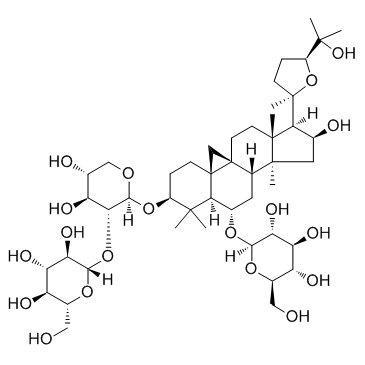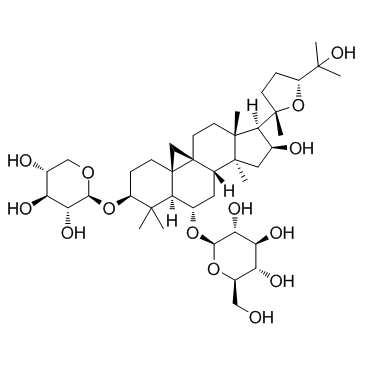Astragaloside VI
Modify Date: 2024-01-01 18:38:40

Astragaloside VI structure
|
Common Name | Astragaloside VI | ||
|---|---|---|---|---|
| CAS Number | 84687-45-6 | Molecular Weight | 947.11100 | |
| Density | N/A | Boiling Point | N/A | |
| Molecular Formula | C47H78O19 | Melting Point | N/A | |
| MSDS | N/A | Flash Point | N/A | |
Use of Astragaloside VIAstragaloside VI could activate EGFR/ERK signalling pathway to improve wound healing. |
| Name | astragaloside VI |
|---|---|
| Synonym | More Synonyms |
| Description | Astragaloside VI could activate EGFR/ERK signalling pathway to improve wound healing. |
|---|---|
| Related Catalog | |
| Target |
EGFR |
| In Vitro | Pretreatment with Astragaloside VI (AS-VI) at 1 μM increases EGFR activation in HaCaT cells. Astragaloside VI, a major intestinal metabolite of astragalosides, exerts the strongest EGFR activation. In HaCaT cells, the positive control, EGF expectedly results in 1.5±0.03-fold increase in cell proliferation, compared to the control. Astragaloside VI at the indicated concentrations also significantly promots cell proliferation in both HaCaT and HDF cells[1]. Astragaloside VI promotes neural stem cell proliferation and enhances neurological function recovery in transient cerebral ischemic injury via activating EGFR/MAPK signaling cascades[2]. |
| In Vivo | Astragaloside VI improves wound healing, compared to the control. In the simple noninfected wound model, wound healing in mice is accelerated by Astragaloside VI, where in the time required for wound closure is shortened by approximately 2-4 days, compared to that in the control group. Topical treatment with Astragaloside VI reduces the volume of pus produced, compared to the control group. Astragaloside VI treated wounds show an accelerated rate of healing, compared to the control and vaseline groups. By day 22, the Astragaloside VI -treated wounds fully close, whereas the blank and vaseline-treated wounds do not fully close until day 26. Angiogenesis is a crucial step in the formation of granulation tissue and wound healing. Astragaloside VI increases blood vessel formation in both the non-infected and infected wound models[1]. Astragaloside VI could effectively activate EGFR/MAPK signaling cascades, promote NSCs proliferation and neurogenesis in transient cerebral ischemic brains, and improve the repair of neurological functions in post-ischemic stroke rats[2]. |
| References |
| Molecular Formula | C47H78O19 |
|---|---|
| Molecular Weight | 947.11100 |
| Exact Mass | 946.51400 |
| PSA | 307.37000 |
| Storage condition | 2-8°C |
| Precursor 0 | |
|---|---|
| DownStream 1 | |
| MFCD17214426 |
 CAS#:83207-58-3
CAS#:83207-58-3